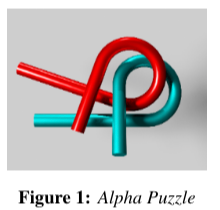Submitted by Anita Shiva on


Picture two rigid metal pieces tangled together. What steps would you take to untangle them?
The most straightforward approach involves twisting each wire to line up the gaps and then pulling one through the other. The design of wire puzzles becomes more complex, like the ones below.

At The University of Texas at Austin and McGill University, researchers are examining the geometrical aspects of puzzle creation and resolution. Dr. Xinya Zhang, a recent UT Computer Science doctoral graduate, collaborated with professors Dr. Etienne Vouga from UT Austin's Department of Computer Science and Dr. Paul Kry from McGill University's School of Computer Science. Together, they explored mathematical methodologies and theories in puzzle design, aiming to establish precise criteria for delineating the characteristics of a puzzle.
A large bulk of previous research in puzzles tends to focus on the variability of solutions. However, there is little work designating the criteria for a puzzle’s design. The team chose to investigate wire puzzles because their design makes it possible to perform a geometrical assessment of the puzzle’s qualities and solutions.
“It was the simplest geometry that could still give us interesting, non-trivial puzzles,” Vouga says.
Their primary consideration in puzzle selection was the requirement for a challenging experience.
“[If we look at non-puzzles], such as a nut and a bolt. There’s not really much of a choice of what to do. You only screw it back and forth. On the other hand, if you have something like a hook on a ring, there’s lots of flexibility there. It’s also unconstrained,” says Kry.
Flexibility makes the wire puzzle a perfect option to assess a puzzles’ level of challenge, as there are many different ways to move the wires around. The structure of the wire is referred to as a tunnel if it is straight and narrow, and as a curved pipe if it is not. The presence of bubbles, or the areas where the wires are loosely entangled, provides the space for the puzzle-solver to figure out a configuration to separate the wires. The team determined that in order for a wire puzzle to be considered challenging, it must contain curved pipes in its tunnel-bubble structure.
The team also hypothesized this tunnel-bubble structure is effective in discerning puzzles from non-puzzles. Additionally, they noticed that disentanglement puzzles involved twisting moves to entwine segments of the two pieces around each other. The team proposes that absence of twistiness is a strong indicator of a non-puzzle. Since the wires themselves are still rigid, which lends itself to a computational analysis.
To look for the existence of tunnel-bubble structure, the researchers created two quantitative metrics. With each disentanglement puzzle, they computed a solution (using an algorithm created in the team’s previous study). Although the computed paths were not always the most optimal, or efficient, solution, it makes them more realistic since a puzzle is solved if any solution is found. Their approach also takes into account other steps a puzzle-solver may take, like finding a dead end or retracing their steps.
To find the tunnel-bubble, or loops, in structures in the two wires of disentanglement, researchers introduced a metric of visibility volume. Visibility volume looks at how much clearance or area there is before the puzzle-solver collides with another wire. Remember, the point of solving a disentanglement puzzle is to untangle the wires without them touching.
The team ultimately concluded that these features can contribute to an optimization model of a puzzle. Although their model could not comprehensively look at every aspect of a puzzle, it was effective at establishing a set of criteria for their future work. Their next step toward achieving that goal is to look at even more flexible puzzles, such as those with a rope.
“[Those puzzles] make the wire metal puzzles look easy, because their rigid objects. The algorithm would be much more challenging to compute,” Kry says.
With each puzzle they study, the team continues to examine components of their structure that make the puzzle challenging and enjoyable to its users. Ultimately, the team’s goal is to utilize this criteria to come up with their own unique design.







